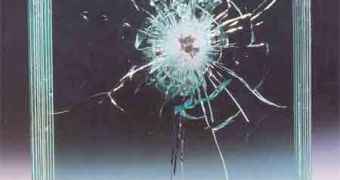Some people, even today, call this type of material bulletproof glass. The fact is that it is anything but bulletproof. By definition, this special type of glass is able to resist one or more rounds shot from a firearm before losing the properties that allow it to stop bullets. Its primary objective is not even to stop the projectiles, but to protect a certain target for a limited amount of time, thus giving it a chance to escape a possible firearm assault.
Bullet-resistant glass is basically made up of multiple layers of ordinary glass alternated with layers of polycarbonate material which are inserted through a process widely known as lamination. Thus, the glass piece is thickened and it is also given some additional properties characteristic to polycarbonates.
Depending on the manufacturing process applied by the company producing the bullet-resistant glass, particular sheets of material can reach thickness levels varying between 7 and 75 millimeters.
How it works
When a high speed projectile impacts bullet-resistant glass, it basically shatters through the outer layer of ordinary glass, after which it encounters the tough transparent plastic. Part of the energy of the projectile is absorbed into the glass shattering process, while much of the remaining energy is dissipated into the polycarbonate layer over a great surface area. If the energy is not completely released in the first layers, then it will surely be in the next ones so in the end the bullet does not escape the final layer and penetrate to the other side.
As the glass layers shatter, the bullet-resistant glass loses part of its structural integrity, thus after a limited number of rounds one bullet will finally make it to the other side and the structure will be unable to withstand further fire and ensure protection anymore. This type of glass can resist bullets coming from either side, thus in case the target wants to return fire they would not be able to do so.
However, one-way bullet-resistant glass is available on the market, having the ability to resist bullets coming from one side of the glass while bullets fired from the other side can penetrate the structure with relative ease. One-way bullet-resistant glass is manufactured by creating a brittle layer coated with a flexible material only on one side.
Bullets coming from the side facing the brittle layer lose part of the energy by penetrating it, while the remnant force of the impact is distributed evenly in the flexible layer so that the projectile is stopped from going through the structure. However, when shot from the other side, a projectile will encounter little resistance from the flexible layer as pressure is concentrated on a single spot, rather than on a large surface, thus easily making it to the other side to hit the target.

 14 DAY TRIAL //
14 DAY TRIAL //